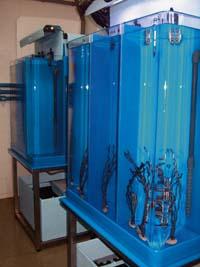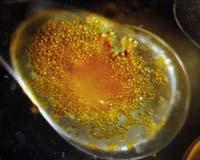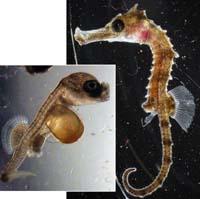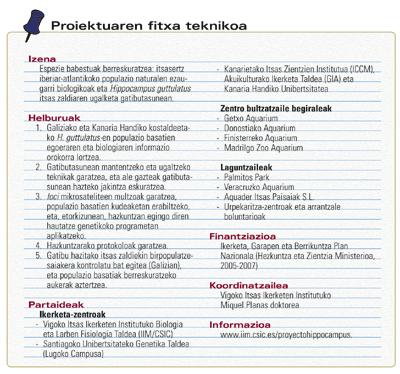Sea horses in danger of extinction

The name of sea horses is due, as is obvious, to its similarity with the land horses. In fact, they have a four-legged, horse-shaped face and an end. But there the similarities end.
Particularities of the matter
Among the anatomical characteristics of the marine horse stand out the circular end and the eyes that move by themselves. With a narrow body and skin skeleton of oscopic rings, its kneading clay is very useful for joining between the algae, so that the fluctuations of the waves and marine currents cannot leave the marine horse adrift. The sea horses do not have caudal fins or anal. They move horizontally thanks to dorsal and pectoral fins, providing stability, direction and vertical movement both the swim bladder and the pectoral fin. And to survive, the strategy of marine horses is camouflage: they mimic perfectly between the algae thanks to their ease to change color and their ability to produce filaments.

Marine horses live in specific biological regions, but at the same time are found in calm waters of the tropical, subtropical and temperate seas of the world. In fields of algae, mangroves, coral songs and estuaries find an ideal place to live.
In the Cantabrian only two species live, Hippocampus hippocampus (common sea horse) and Hippocampus guttulatus (sea horse with stripes). They are very similar, but have different beaks -- H. guttulatus is smaller -- and appendices of head and back -- in this case, H. guttulatus are greater --. Depending on where they live they can be black, brown or yellow and can reach a length of 14 cm. The algae fields of our coast, which do not depend much on the waves, are ideal places to contemplate specimens of Hippocampus hippocampus and Hippocampus guttulatus, increasingly scarce.
Marine horses dedicate almost all day to feeding. And they are cofine. Fish that grow captive eat dead food or feed, but sea horses only eat live food. Copepods, artemias and miswriting, small crustaceans, are a good part of their diet. When one of these crustaceans is placed next to it, they absorb it from the small peak with a quick head blow. Having no teeth, the dams are swallowed in their entirety, and because they do not have the belly very developed, they have to take a lot of food to match a fast and ineffective digestion.

However, the characteristics of these fish are not the ones mentioned so far. The most curious thing is reproduction. At the time of the equalization, the marine horses perform a spectacular nuptial dance: the male and the female join by the tail and dance until the eggs carried by the female are left in the bag of incubation of the male. In this pouch a fecundation occurs where the offspring breed. According to the species, the offspring that pass between 3 and 5 weeks in the bag. From there they leave with an aspect similar to the adult, miniatures of marine horses. Therefore, it can be said that in these “pregnant” fish the male is a spectacular fact in the animal world. It should also be noted that marine horses form couples for the whole life.
In danger
These delicate beings are in danger of extinction from the seas. Sea horses are fished in Asia, mainly in the Philippines, Thailand, India and Vietnam. In these lands they are highly appreciated for eating, but most of the catches are used in traditional Chinese medicine. The dry marine horse is the basic component of almost all supposed remedies: cure asthma, arterosclerosis and impotence, thyroid alterations and heart problems. They also say he is aphrodisiac! Science has not yet shown that marine horses are effective in medicine, but it gives equal. So appreciated, in Hong Kong it is paid half a kilo to 550 dollars.

Not only for medicine, in the world thousands and thousands of marine horses for aquariums are fished every year. They are mainly exported to North America, Europe, Japan and Taiwan. To some extent, the expectation generated by these fish is understandable, but it must be taken into account that marine horses die captive, on the one hand because they are very delicate and on the other, because it is difficult to reproduce in captivity. These two uses are the main threats to marine horses, but not the only ones: they are increasingly used as ornaments and crafts, and they are deteriorating the habitat.
If threats are added to the weakness of marine horses, the result is that the number of marine horses has decreased by 75% in recent years. As a result of this worrying fact, CITES (Convention on International Trade in Endangered Wild Fauna and Flora) included in November 2002 the entire Hippocampus genus in the second annex to the species protection agreement. Thanks to this, the purchase of live specimens, dead specimens and products derived from them are strictly regulated.
Protecting our marine horses
Also on our coast was launched in 2005 the Hippocampus project to protect marine horses. The project has several objectives, but can be summarized in two: the recovery of natural populations and the reproduction in captivity of the marine horses of the species Hippocampus guttulatus.

However, the first work has been to enrich the scarce scientific documentation on this species, since before repopulating the natural territories it was necessary to investigate the biology and environment of wild populations. Thus, they decided to investigate two regions: Galician coast and Canary Islands. At the same time, in order to carry out future repopulations, it was necessary to develop breeding techniques, decide where these repopulations would be carried out, and develop a pilot repopulation program to investigate if possible the recovery of populations by introducing specimens that have grown in captivity in a natural environment.
For the development of such an ambitious and complex project, research centers, important aquariums and aquarophilia companies have participated. And the effort made has begun to bear fruit, some of the objectives of the project have already been met.
On the one hand, the University of Santiago has created a genetic library of Hippocampus guttulatus, to collaborate in the evaluation of the natural and genetic resources cultivated in this species. This tool will allow to have stocks of reproducers grown in captivity and maintain genetic diversity minimizing the fraternity between reproducers.

For its part, the Marine Research Institute of Vigo has designed special aquariums so that the reproducers of H. guttulatus are in the best possible conditions. These new aquariums incorporate mechanical, chemical and biological filters, water pumping and cooling systems and lighting systems. The prototypes were tested in 2005-2006 with wild sea horses collected there and have functioned properly. The marine horses quickly adapted to the new house, proof of this success are the continuous bark and the offspring achieved. The work being carried out in Vigo will serve not only to obtain groups of reproducers, but also to know the biological characteristics of the species.
For its part, the Aquaculture Research Group, the Instituto de Ciencias Marinas de Canarias and the University of Gran Canaria have carried out an extensive investigation of the wild populations of marine horses of their coasts. Specifically, they have worked with H. hippocampus, where there is no H. guttulatus, and have seen significant differences between both species. These differences make H. hippocampus seem easier to reproduce in captivity. Several generations of marine horses in captivity have been obtained at the Instituto de Ciencias Marinas de Canarias and some specimens can be seen in the Getxo Aquarium, in the acurio, along with other marine horses of the same species.
One of the objectives is, therefore, that marine horses reproduce in captivity. But we must not forget that this objective is also a step within the second objective, since the main objective is to repopulate the sea, that is, the natural environment, using individuals raised in captivity. For this purpose, more tools have been developed.
The University of Santiago de Compostela and the Marine Research Institute of Vigo have developed tools for the identification of marine horses. And it is that physical and genetic identification is necessary for crosses to conform to genetic characteristics. Among the techniques developed are the use of necklaces labeled Alpha TAG and the genetic analysis of samples taken from filaments or dorsal fin, techniques that do not harm marine horses.
This type of projects promote the conservation of marine biodiversity, in this case of sea horses, but in the conservation of the planet, without great efforts, can participate the whole society. In the case of sea horses, it is enough that there are no sea horses in the aquarium of the house or that do not buy dry horses for ornamental use. With these small actions we will contribute to eliminate a tacit business that kills hundreds of thousands of marine horses every year.

Buletina
Bidali zure helbide elektronikoa eta jaso asteroko buletina zure sarrera-ontzian










